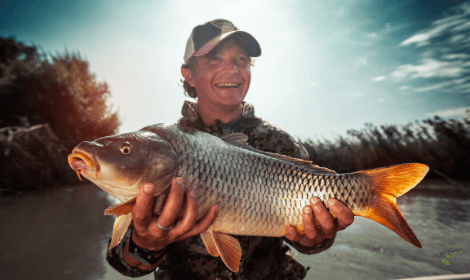
Many new anglers or people interesting in getting into carp fishing often ask about the best methods to catch carp.
There is a multitude of methods used to fish for carp, and this wide range of tactics, gear, and methods can overwhelm anglers when they first start dipping their toes into the world of carp fishing.
In this article, we will take a look at how to catch carp, along with various types of gear and tactics.
Carp Fishing Methods and Rigs
As mentioned in our introduction to this article, there are many different tactics and gear used in carp fishing; while this may be confusing or overwhelming to new anglers, it will all become familiar with time, and you can start by using basic methods to catch fish right away, the rest will come with time and experience, let’s break down some carp fishing tactics.
Carp Rigs
Carp rigs used as a beginner should be kept simple, with weighting, hook, and bait lead. While simple, they are incredibly effective and the most commonly used type of rig among all carp anglers. Once you get some experience with simple rigging options, you can start looking into using pop-up rigs and other more complicated setups.
Chod Rig
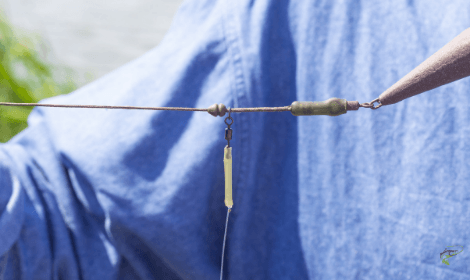
Once you get some rigging experience under your belt, you can explore rigging options such as for chod rigs. Chod rigs are a type of pop-up rig that keeps the bait a few inches off of the bottom, with free movement along the line thanks to a swivel and some line stops to keep the swivel within a designated section of the line, allowing you to fine-tune the exact distance the bait is presented from the bottom of the lake.
The word chod refers to debris, snags or even weed at the bottom of a look. The “chod rig” takes it’s name from this as it is specifically used to suspend you bait above this debris.
This allows your bait to stay in clear view of the perusing carp and avoids your bait getting buried in debris which makes it absolutely useless in terms of catching carp.
Spinner Rig
Spinner rigs have replaced the chod rig for many carp anglers, although the chod rig still has it’s time and place to shine. The Spinner rig simplifies the process and uses a small section of bait link line only a few inches in length that ties directly to the weight. At the end of the bait link line, you have your hook and bait line itself with the floating bait presented.
Surface Rigs
Surface rigs are fairly simple, but they do require technique-specific parts such as floating lines and floating bait types. Bait can be as simple as bread or floating boilies, and many anglers might incorporate materials such as foam or cork into their bait to aid in buoyancy. The key with surface fishing is to keep hooks small and your overall setup as buoyant as possible, obviously excluding any weighting.
Surface rigs can even be as simple as a hook with a piece of bread attached as long as the fish are very close to where you are fishing.
Baiting
Like rigging options, there are also many baiting options to free-bait and hold carp in chosen areas, and this gives you a greater chance for carp to eat your hooked presentation. These tactics are fairly unique in terms of freshwater fishing, as it is typically used for fish like carp and tench, while it is seldom used for other species like pike, zander, or perch.
Spodding
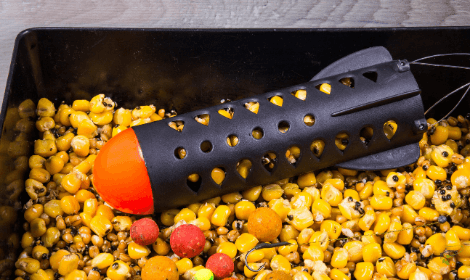
Spodding is one of the free-baiting delivery methods used. And when I first discovered spodding I was completely surprised and interested as I had never seen this method used in any type of fishing. this is one of the tactics that make carp fishing fairly unique.
Spods look like little missiles or bombs that are perforated with holes, and the back end is open. When thrown out to the desired location, the spod impacts the water and deposits the bait out of the open end to the bottom below.
PVA Bags
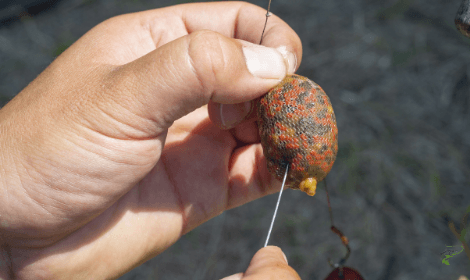
PVA bags originally came from the medical world as a way to wash contaminated clothing or other items. PVA melts away when exposed to water, and it didn’t take long for carp anglers to exploit this reaction.
Smaller PVA bags are commonly used by carp anglers today as a tool used to deliver free bait offerings to carp. They have advantages over spodding when it comes to certain situations.
One advantage with PVA bags is the ability to throw with the rod you intend to fish with instead of having a dedicated heavy spodding rod, and if you can use your actual fishing rod, you can also put the hook and hook bait in the bag itself, guaranteeing that your hook is directly among the free bait offering.
Along with the hook advantage with PVA bags, the free bait itself is very localized and not as widely spread as the bait floating down from a spod. This spreading or lack thereof can be crucial in many situations, especially when baiting with very small amounts of free bait in the winter months.
Spombing
Spombing is essentially the same as spodding, but the method of delivery is slightly different. With spombs, the bait carrying device has a button, that when contacting the water, opens the spomb and releases the contents.
Spombs have the advantage of being able to carry more bait than spods, depending on spomb design and size.
Bait Selections
Along with rigging types and bait delivery gear, the bait selection itself is vast, with a seemingly unlimited number of flavors and sizes. Let’s take a look at the most popular types of bait for carp.
Boilies
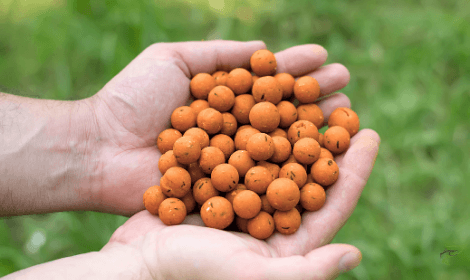
Boilies are one if not the most popular bait type used by carp anglers. Looking like round balls that come in various sizes and flavours. Along with pineapple, shrimp, and blood meal flavours, there is also a variation known as pop-up boilies, these boilies float and are used extensively with rigging options like the chod and spinner rigs mentioned above, along with surface fishing rigs.
Pellets
Pellets are commonly used when spodding or free-baiting but are also used as hook bait as well. Pellets look similar to pellets used to feed rabbits are much smaller than the average boilie, and again the flavors are endless.
Natural Baits
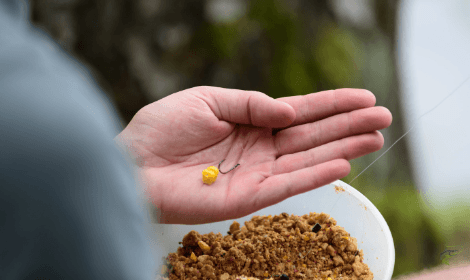
One of the most popular natural baits that always works and is available in any supermarket for cheap, is sweetcorn. Carp love sweetcorn, and carp anglers love fishing sweetcorn. But, along with corn, carp also love other readily available natural bait such as worms, maggots, bread, and more.
Along with these natural baits, you can also find fake imitations for all of them, even fake bread imitations.
Many anglers overlook these natural presentations and get completely lost in the bait selection puzzle with the plethora of flavours, sizes, and colours. While these bait factors are something to be considered, sometimes as an angler you need to step back, and bring your bait selection back to the basics, and watch how effective simplicity can really be.
Weather and Seasons
Changes in season and weather have impacts on any fish species and their feeding behavior. This section will give an insight into how these factors affect carp and their feeding.
Weather
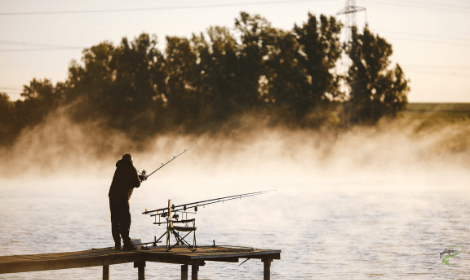
Carp fishing is typically best suited to calm days, although wind can be an anglers friend. The wind blows food onto the shoreline on the downwind side of the lake or pond. Wind blowing in the same direction for multiple days on end can help you as an angler determine where you should be fishing, as carp are likely stacked up on one end of a pond or lake.
Cloudy days can also be exceptionally good days, as carp feel more secure under overcast skies and you may find the fish in the shallows en masse with quite a bit of them actively feeding.
Barometric pressure is also a major consideration when fishing for any species. Changes in pressure to do weather will have a major effect on a carps feeding behaviour.
When a low front approaches this typically means a storm or rain in the summer months, and the barometer will start to dive, this is a great indicator of a positive feeding mood for all fish, so be sure to fish during these times.
Likewise, after a storm has passed and the weather turns clear and sunny that day, or the day after the storm the pressure will change and start to rise. Generally anytime a barometer is moving there’s potential to catch fish, but when a barometer climbs and stabilizes the fish tend to be in a negative mood, and during high pressure conditions will typically be in shallow water and heavy cover without much in terms of feeding activity.
You can find more on how the weather affects carp fishing in this post.
Seasons
The warm water seasons of spring, summer, and autumn are the most productive times to catch carp. Warm water means increased metabolism, which means feeding is frequent, and this puts you in a position to catch more carp.
The summer is a great time to try fishing tactics and rigs that you aren’t familiar with as carp typically feed often, giving you the chance to experiment and catch plenty of fish along the way.
Summer is also a great time to dial in on surface fishing or even catching carp on the fly, as fish will feed frequently from the surface. While surface fishing doesn’t work every time you’re on the water, you will definitely stumble onto great surface action on and off throughout the summer months.
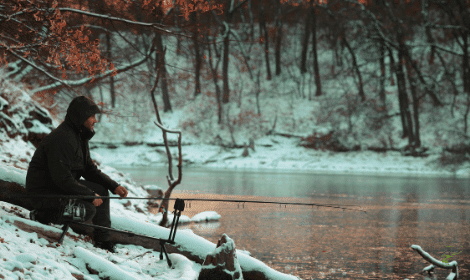
The winter can be difficult for beginner anglers, but fish can still be caught in the winter months. This requires knowledge and planning, as the fish feed very seldom in the cold water due to energy conservation and a lack of metabolism, this is the result of being cold-blooded creatures
In the winter months you should bait as little as possible, and you should focus on fishing very specific spots at precise times. You should free bait as little as possible to avoid filling the fish up before catching them, and over baiting too often can actually kill the feeding activity on a small body of water for days or more.
Locations
Carp inhabit and feed in different locations depending on the conditions. In the spring and summer months, you can find carp near to shore regularly, while in the winter, they most likely are in deeper water if it is available and close to the bottom.
In certain weather conditions and seasons, tactics like margin fishing close to shore with unweighted baits can be incredibly exciting. Stalking and margin fishing is usually sight fishing, with you seeing your intended target and presenting a bait directly to it.
It’s important if you plan on stalking and margin fishing to be as stealthy as possibly. Do not stomp your feet or walk haphazardly up to the shore line with excessive movement, this will spook the carp and burn out that spot for a period of time.
Wearing dark, grey, or even a camouflage shirt can also help you out when stalking the shoreline, allowing you to blend in to the surrounding foliage and keeping the carp unaware of your existence.
Trees, roots, shrubs, and other nearshore areas can be abodes for carp, and stalking these areas can provide you with tons of actions. Likewise, long-distance casting in these areas can also provide great opportunities.
As with most fish, carp also love submerged and emergent vegetation. Areas like shallow reed beds, weed beds, and nearshore vegetation will hold carp. Some of these areas, like weed beds, require you to tailor your presentations in order to avoid snagging and allowing the fish to actually see and feed on your bait. When fishing these areas, look for bare spots and lanes to present your bait, these form natural highways which allow big carp to follow paths of least resistance.
For lower standing submergent vegetation, you can use rigs like the ones mentioned above and modify the lengths to get your pop-up boilie to sit inches above the vegetation, this can be an incredible presentation, as any carp cruising over the low laying weed beds can see and easily eat your bait.
That’s All!
Carp fishing is a very complex form of fishing that can at times be frustrating to new anglers. Starting out you should keep things basic and simple, but over time you will accrue knowledge on various tactics and rigging options to aid you in your carp catching adventures.
How to catch carp doesn’t have one simple answer, and the scope of that answer is larger than a blog post, and just when you think you have it figured out, mother nature will throw you a new challenge.

